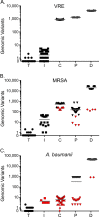Application of whole-genome sequencing for bacterial strain typing in molecular epidemiology
- PMID: 25631811
- PMCID: PMC4365209
- DOI: 10.1128/JCM.03385-14
Application of whole-genome sequencing for bacterial strain typing in molecular epidemiology
Abstract
Nosocomial infections pose a significant threat to patient health; however, the gold standard laboratory method for determining bacterial relatedness (pulsed-field gel electrophoresis [PFGE]) remains essentially unchanged 20 years after its introduction. Here, we explored bacterial whole-genome sequencing (WGS) as an alternative approach for molecular strain typing. We compared WGS to PFGE for investigating presumptive outbreaks involving three important pathogens: vancomycin-resistant Enterococcus faecium (n=19), methicillin-resistant Staphylococcus aureus (n=17), and Acinetobacter baumannii (n=15). WGS was highly reproducible (average≤0.39 differences between technical replicates), which enabled a functional, quantitative definition for determining clonality. Strain relatedness data determined by PFGE and WGS roughly correlated, but the resolution of WGS was superior (P=5.6×10(-8) to 0.016). Several discordant results were noted between the methods. A total of 28.9% of isolates which were indistinguishable by PFGE were nonclonal by WGS. For A. baumannii, a species known to undergo rapid horizontal gene transfer, 16.2% of isolate pairs considered nonidentical by PFGE were clonal by WGS. Sequencing whole bacterial genomes with single-nucleotide resolution demonstrates that PFGE is prone to false-positive and false-negative results and suggests the need for a new gold standard approach for molecular epidemiological strain typing.
Copyright © 2015, American Society for Microbiology. All Rights Reserved.
Figures

Comment in
-
Integration of whole-genome sequencing into infection control practices: the potential and the hurdles.J Clin Microbiol. 2015 Apr;53(4):1054-5. doi: 10.1128/JCM.00349-15. Epub 2015 Feb 11. J Clin Microbiol. 2015. PMID: 25673795 Free PMC article.
References
-
- Field N, Cohen T, Struelens MJ, Palm D, Cookson B, Glynn JR, Gallo V, Ramsay M, Sonnenberg P, Maccannell D, Charlett A, Egger M, Green J, Vineis P, Abubakar I. 2014. Strengthening the Reporting of Molecular Epidemiology for Infectious Diseases (STROME-ID): an extension of the STROBE statement. Lancet Infect Dis 14:341–352. doi:10.1016/S1473-3099(13)70324-4. - DOI - PubMed
Publication types
MeSH terms
Substances
Grants and funding
LinkOut - more resources
Full Text Sources

